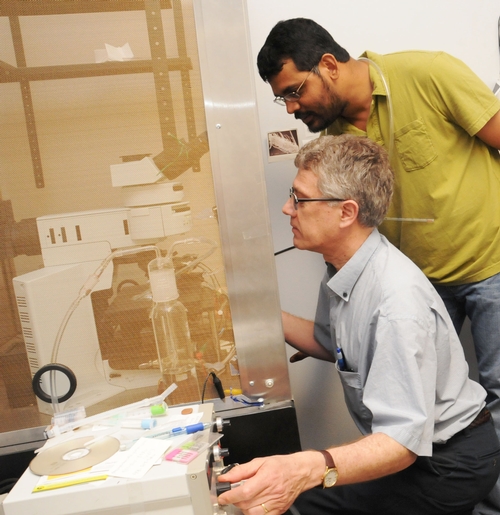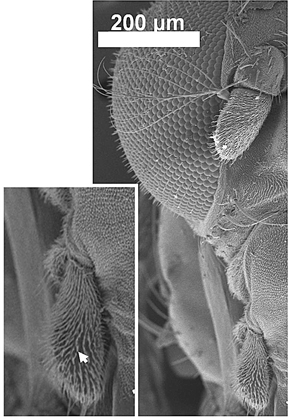- Author: Kathy Keatley Garvey
A gray butterfly and a fruit fly...
Each has "fly" in its name but one is a member of the order Lepidoptera and the other, order Diptera. Etymology does not agree with entomology.
Ever managed to photograph a butterfly and fruit fly in the same image?
Presenting: a gray hairstreak butterfly, Strymon melinus, and a fruit fly, Neotephritis finalis, an organism commonly known as "the sunflower seed maggot."
They were foraging March 21 in a Vacaville garden on Coreopsis, a genus of flowering plants in Asteraceae.
N. finalis, one of the most commonly seen fruit flies (tephritids) flies in North America. develops in the seed heads of plants in the sunflower family. They're also called "picture-winged flies." BugGuide.net tells us "Wings are mostly dark in apical half with six hyaline spots forming a distinct triangle."
The wings are indeed striking!
But so are the wings of the gray hairstreak butterfly. That orange spot with a black dot on the hindwing probably resembles an eye to a predator.
Butterfly guru Art Shapiro, UC Davis distinguished professor emeritus, says on his research website that the gray hairstreak "is one of the most polyphagous butterflies known, recorded on host plants in many families. Its most frequent hosts in our area are mallows, including the weedy species of Malva; legumes, including Spanish Lotus (Lotus purshianus), Bird's-Foot Trefoil (Lotus corniculatus), White Clover (Trifolium repens) in lawns, Alfalfa (Medicago sativa) and many others; and Turkey Mullein (Eremocarpus or Croton setigerus, Euphorbiaceae)."
Maybe we'll see the butterfly and the fruit fly again...
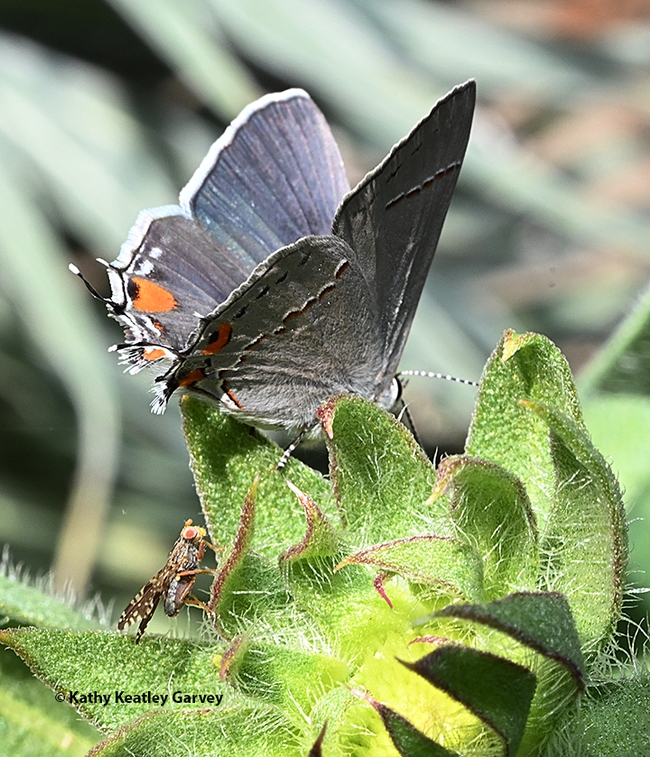
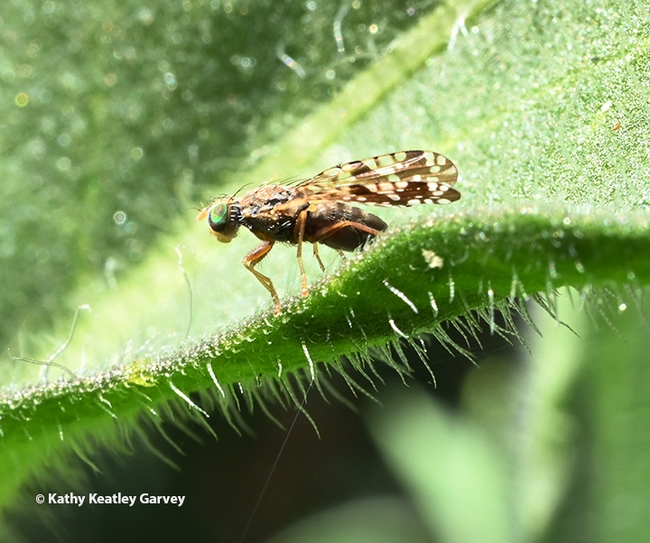
- Author: Kathy Keatley Garvey

It's long been a model organism for biological research in such fields as genetics, physiology, microbial pathogenesis and life history evolution.
And now, a New York scientist is studying the circadian and homeostatic regulation of sleep in these fruit flies.
Orie Shafer, professor of biology and cognitive neuroscience, City University of New York, will share his research on Monday, Feb. 5 in a seminar hosted by the UC Davis Department of Entomology and Nematology.
Shafer will discuss "Circadian and Homeostatic Regulation of Fly Sleep" at 4:10 p.m. in Room 122 of Briggs Hall, and also on Zoom. The Zoom link:
https://ucdavis.zoom.us/j/95882849672.
"Sleep-like states are ubiquitous in the animal kingdom and are regulated by two distinct forms of regulation, circadian and homeostatic," Shafer says in his abstract. "Homeostatic mechanisms promote increases in sleep pressure during prolonged wakefulness. Circadian mechanisms determine the likelihood of sleep, increasing or decreasing its probability across the day. Though the molecular and neural mechanisms of circadian timekeeping are relatively well-understood, much less is known about the mechanistic basis of sleep homeostasis. The fly Drosophila melanogaster is a powerful model organism for the studying of sleep regulation. In this talk I will describe recent work from my lab examining how circadian timekeeping and sleep homeostasis operate in this fly and how these two regulatory processes converge to produce the proper timing and amount of sleep."
Shafer will be introduced by molecular geneticist and physiologist Joanna Chiu, professor and chair of the department. He received his doctorate in biology from the University of Washington, and served as a postdoctoral researcher at Washington University School of Medicine, St. Louis.
In a YouTube video with Abhilash Lakshman on "Circadian and Homeostatic Regulation of Sleep in an Insect Brain," Shafer points out that "Sleep is largely controlled by two processes--a circadian clock that regulates its timing and a homeostat that regulates the drive to sleep." In the video, he discusses some of the fundamental biology involved in human and fly sleep. Lakshman describes "an elegant two process model in which the circadian and homeostatic components act independently, bringing theory and experiment together for a new understanding of fly sleep."
D. melanogaster feeds on rotting fruit and fermenting beverages, and is often found not only in orchards, but in kitchens and bars.
Charles W. Woodworth proposed in 1901 that D. melanogasterbe used as a model organism. "As of 2017, six Nobel Prizes have been awarded to drosophilists for their work using the insect," according to Wikipedia. "D. melanogaster is typically used in research owing to its rapid life cycle, relatively simple genetics with only four pairs of chromosomes, and large number of offspring per generation. It was originally an African species, with all non-African lineages having a common origin. Its geographic range includes all continents, including islands. D. melanogaster is a common pest in homes, restaurants, and other places where food is served."
For any Zoom technical issues, contact seminar coordinator Brian Johnson, associate professor, at brnjohnson@ucdavis.edu. See complete list of seminars for the winter quarter.
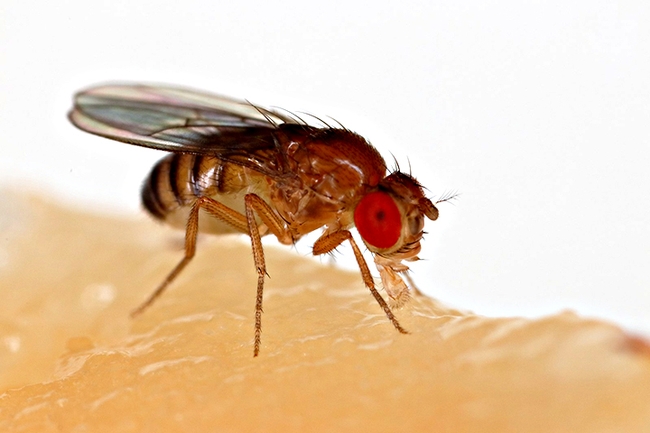
- Author: Kathy Keatley Garvey

Those are some of the questions that Wolf asks. "We aim to find some of the molecular and neural circuit mechanisms that govern adult behavior in the fruit fly Drosophila."
Wolf, who holds a doctorate in molecular and cell biology from UC Berkeley, will speak on "Drinking Drosophila and Drunk Drosophila: Genes and Circuits for Simple Behaviors" at the next UC Davis Department of Entomology and Nematology seminar, set for 4:10 p.m., Wednesday, Oct. 31 in 122 Briggs Hall.
"How is motivation coded in a small brain?" Wolf asks. "How does a natural motivation like a thirst differ from drug-seeking in addiction? We use circuit mapping, genetics and behavior in Drosophila melanogaster to find out internal states combine with environmental information to select behavioral programs and suppress others."
Molecular geneticist Joanna Chiu, associate professor and vice chair of the UC Davis Department of Entomology and Nematology, will introduce the speaker and serve as the host. Medical entomologist Geoffrey Attardo coordinates the fall seminars.
The Drosophila fly nervous system is remarkable. Wolf says it's "a million-fold simpler than ours, yet flies are capable of carrying out remarkably sophisticated tasks that are modified by past experience and internal states. However, the biological bases for even simple behavioral actions that serve as models for more complex tasks remain mysterious. Understanding how circuits function in a model organism where rapid progress can be made with highly sophisticated tools is likely to provide insight into how more complicated brains work."
No wonder that Drosophila melanogaster, is a favorite model organism among biomedical researchers.
"There are many technical advantages of using Drosophila over vertebrate models; they are easy and inexpensive to culture in laboratory conditions, have a much shorter life cycle, they produce large numbers of externally laid embryos and they can be genetically modified in numerous ways," according to Barbara Jennings in ScienceDirect.com. "Research using Drosophila has made key advances in our understanding of regenerative biology and will no doubt contribute to the future of regenerative medicine in many different ways."
"Over the past four decades," Jennings points out, "Drosophila has become a predominant model used to understand how genes direct the development of an embryo from a single cell to a mature multicellular organism." Indeed, numerous scientists have won Nobel Prizes for their research on the fruit fly.
What does the scientific name, Drosophila melanogaster, mean? Drosophila means "dew lover" and melanogaster means "dark gut."
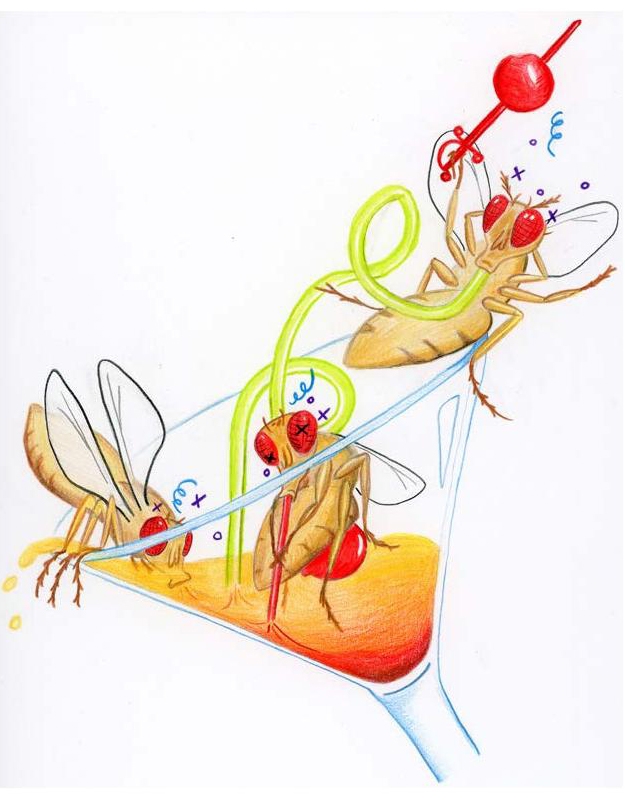
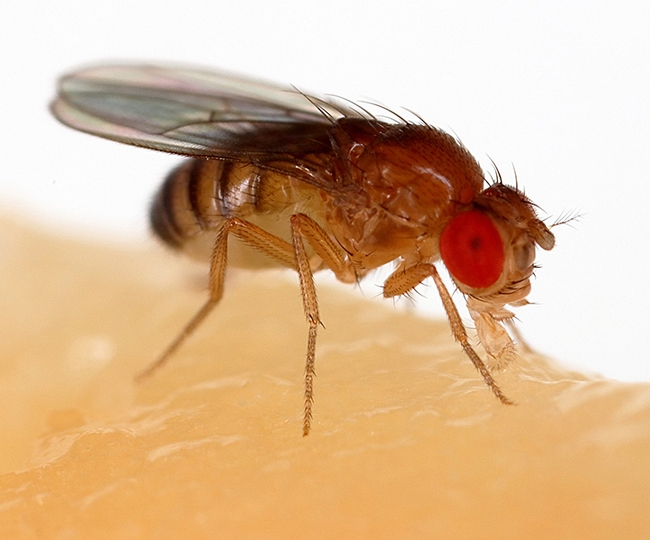
- Author: Kathy Keatley Garvey

If you want to know more about circadian timing and why "circadian timing is everything"--from human beings to fruit flies--don't miss the Science Café session on Wednesday night, March 8 at Davis.
Molecular geneticist Joanna Chiu, vice chair of the UC Davis Department of Entomology and Nematology, will speak on "Circadian Timing Is Everything: From a Good Night's Sleep to Minimizing Insecticide Use" at the Science Café session at 5:30 p.m., Wednesday, March 8 in the G St. Wunderbar, 28 G St., Davis.
Professor Jared Shaw of the UC Davis Division of Math and Physical Science is hosting the informal session. Free and open to all interested persons, it is sponsored by the Capital Science Communicators and the UC Davis Department of Chemistry. Science Café events take place in casual settings and aim to feature an engaging conversation with a scientist about a particular topic.
Chiu, an associate professor who specializes in molecular genetics of animal behavior, joined the UC Davis Department of Entomology faculty in June 2010. She received her doctorate in molecular genetics from the Department of Biology at New York University.
"All living things on our planet, from bacteria to humans, organize their daily activities around the perpetuating 24-hour day-night cycles, the result of earth rotating on its own axis and orbiting around the sun," Chiu says. "In order for organisms to anticipate predictable variations in their environment that naturally occurs over the 24-hour cycle and coordinate their physiology and behavior to perform at their best, they rely on an internal biological clock. At the science cafe presentation, I will discuss how this internal clock, termed the circadian clock, affects many important aspects of our lives, including the timing of when we feel tired and want to go to bed, the time-of-day our immune systems are most susceptible to pathogen attack, and even when medicines should be taken to give you 'the most bang for your buck.'" In addition, I will discuss the consequences of when the circadian clock is 'broken' or 'off-kilter' because of diseases, work-schedule, jetlag, and light pollution."
Back in 2011, Chiu and colleagues from Rutgers University, the State University of New Jersey, published their work on the fruit fly, Drosophila melanogaster, describing how they identified a new mechanism that slows down or speeds up the internal clock of fruit flies. That research, published in the journal Cell, has important implications: it could lead to discoveries on alleviating human sleep disorders.
By mutating one amino acid in a single protein, “we changed the speed of the internal clock and flies now ‘think' it is 16 hours a day instead of 24 hours a day,” Chiu explained in a 2011 interview. “Our goal, of course, is not to trick flies into thinking the day is shorter or longer, but to dissect this complex phospho-circuit (phosphorylation sites) that controls clock speed in metazoans.”
“Living organisms—plants, animals and even bacteria—have an internal clock or timer that helps them to determine the time of day," she said in that 2011 interview. "This internal clock is vital to their survival since it allows them to synchronize their activity to the natural environment, so that they can perform necessary tasks at biologically advantageous times of day.”
“A functional clock is required to generate proper circadian rhythms of physiology and behavior including the sleep-wake cycle, daily hormonal variations and mating rhythms,” Chiu said. “Based on genetics, molecular biology and biochemical experiments performed in many different model organisms, we know that the speed of the internal clock is controlled by a core set of circadian proteins."
So if you aren't getting that good night's sleep and you're wondering about that internal clock, be sure to head over to the G St. Wunderbar on March 8. You'll learn the connection between circadian timings and minimizing insecticide use, too.
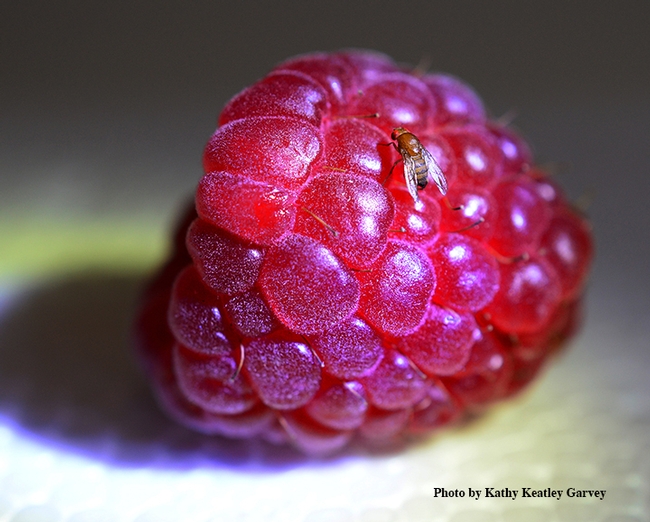
- Author: Kathy Keatley Garvey
Researchers in the Walter Leal lab, UC Davis Department of Entomology, are engaging in some exciting research.
They just discovered a "generic insect repellent detector" in the fruit fly (Drosophila melanogaster)--research published today (March 16) in PloS One (Public Library of Science).
What's exciting is that this research may lead to more effective and lower-cost products than DEET, the gold standard of insect repellents.
The five-member team found the sensory organs involved when fruit flies detect and avoid three key insect repellents: DEET, IR3535 and picaridin. They identified the olfactory receptor neuron (ORN) and characterized its receptor, DmOr42a.
The research team of Leal; primary author and chemical ecologist Zain Syed; chemical ecologist Julien Pelletier; and undergraduate students Eric Flounders and Rodrigo Chitolina, first found that the fruit fly avoids all three well-known repellents, DEET, IR3535 (a compound known as Avon Corporation’s “Skin-So-Soft Bug Guard”) and picaridin (derived from pepper) and then set out to find olfactory receptor neurons sensitive to those insect repellents. They scanned all olfactory sensilla in the antennae and the mouthpart structure, maxillary palps, using single unit electrophysiological recordings.
The receptor they found “fulfills the requirements for a simplified bioassay for early screening of test insect repellents,” they wrote in the scientific paper.
When you think that it takes about 10 years and $30 million to develop a new repellent--and only one test compound in 20,000 reaches the market--this could really speed up the process.
Zain Syed told us: "In this study, by using established behavioral assays to dissect the mechanism of repulsion in fruit flies, we demonstrated for the first time that Drosophila equally avoid other repellents--picaridin and IR3535. By challenging every type of olfactory sensilla on the antenna and maxillary palps, we identified neurons and then the odorant receptor that detect these repellents."
The UC Davis research, as Syed said, "adds a new dimension in research towards understanding the molecular, cellular and organismal response to repellents."
Chemical ecologist Coby Schal, the Blanton J. Whitmire Distinguished Professor of Entomology at North Carolina State University, praised the research as “an excellent example of translational research that can lead to a streamlined and less expensive path of discovery of new repellents.”
In earlier research, Syed and Leal identified a DEET-sensitive olfactory receptor neuron in the Southern House mosquito. “Going from the neuron to the receptor, however, is like looking for the proverbial needle in a haystack as the mosquito genome has some 181 olfactory receptor genes,” Schal said.
The Leal lab knows DEET. Back in August 2008, Leal and Syed drew international attention when they announced they'd discovered DEET’s mode of action or how it works. Scientists long surmised that DEET masks the smell of the host, or jams or corrupts the insect’s senses, interfering with its ability to locate a host. The Leal-Syed research showed that mosquitoes actually smell DEET and avoid it because they dislike the smell.
DEET, developed by scientists at the U.S. Department of Agriculture and patented by the U.S. Army in 1946, is the go-to insect repellent. Worldwide, more than 200 million use DEET to ward off vectorborne diseases.
